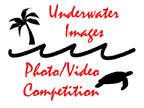Videolights
Creating Quality Photos
101
by Roger Roth
We all want to take the best image we can when we go diving. But what does that actually entail? And what do we have to do to get a quality photo?
The first thing that needs to be conquered is our buoyancy. We can’t be crashing around the reef tearing up everything in our paths, or there would be nothing pretty left to shoot. And we surely can’t have arms flailing or we’d be actually chasing the fish away!
So now we understand the need for good buoyancy and the need to practice that buoyancy. First we need to practice without a camera in our hands, and then we need to practice with it in our hands. Finally, we need to practice holding still with the camera in our hands being sure not to disturb anything in the water or on the seafloor.
After gaining great buoyancy control, we need to understand our cameras. With the onslaught of the digital realm, there are numerous buttons and each may have numerous functions. Again, practice comes into play.
This practice should be done over and over while on land so that we understand all the necessary functions of our cameras. We can start with shooting in auto modes so that we don’t become inundated with every camera function too soon. Nowadays, with the technology what it is, auto focus and auto white balance is quite acceptable for taking good pictures
When we are using artificial light like video lights or strobes, we need to find the best placement of those lights. Again, practice on land is the first place to start but understand that shooting on land doesn’t help overcome the backscatter that occurs while diving because of the particulate matter in the water. Obviously, the next step is to practice light placement and directions of our lights while in the water.
Sometimes pointing light directly at a subject can cause over lighting and a bad picture. Nice lighting effects can be obtained by pointing lights a little away from a subject, possibly highlighting a pretty sponge or coral near the subject. We still need to make sure that we are illuminating our subject enough as well.
To overcome backscatter in the water, our lights need to be held somewhat away from our cameras and then pointing somewhat towards our subjects. If we held our lights next to our cameras and pointed them towards our subjects, the light rays would illuminate any particulate matter in the water and bounce directly back towards our lenses. When we hold the light farther away from our cameras and the light rays hit particulate matter, the bounce back is towards the light and not towards our lenses.
One more thing to always remember is to be close to our subject. The closer we are there will be less particulate matter between our lenses and our subjects, thus making the shot clearer. Also, the closer we are, the more effective our artificial lighting will be remembering that light may only travel three to five feet effectively.
The next step is to learn the other functions of our cameras beyond the auto functions. Changing f-stops, aperture sizes, and white-balancing will change the look of a picture. Again, practicing on land first is suggested so that you can learn and see the differences firsthand of these changes.
Placement of our subject in the picture will also add appeal. For this we need to understand the rule of thirds which is dividing our viewfinder into thirds whether horizontally or vertically or even diagonally. Keeping our subjects along these lines or within these lines will help to create a nice picture.
Considering the background of our pictures is something else to remember to do. A nice colorful background can add a tremendous amount of appeal to any picture, and we all know that there’s usually plenty of color underwater once illuminated. Even mid-water shots can have a nice colorful blue background.
The only time one might consider violating the rule of thirds might be when shooting a picture that will be created for more advertising uses. Think about a magazine cover that will need some room for titles that don’t cover up the subject of the picture. Or maybe we want to have a picture of our first trip to the south Pacific and we want to use Photoshop to label this picture accordingly.
Finally, attempting to show action in our pictures will give them superb appeal. Examples of this would be shooting a fish as it is just turning towards our lenses with a curved body, or shooting divers actually doing something like fanning silt from some coral to keep it healthier. Looking for shots like this will take us a step beyond a simple point and shoot.
Now, go practice. Sea Ya!
Critter corner: If one has a burning desire to shoot fish tails, consider the colors and markings of the tails of the stoplight parrotfish, surgeonfish with their scalpel-like spines at the base of their tails, or even the numerous different butterflyfish tails.
copyright © Roger Roth, 2002 - 2011
Roger Roth is a roofer by trade and lives in Cincinnati, Ohio. But his passion is underwater videography and after several decades of learning how to shoot and edit he has evolved into a teacher and a photographic philanthropist. Roger is the founder of the annual international Underwater Images Photo and Video Competition. You may contact Roger at rroth2@cinci.rr.com.

